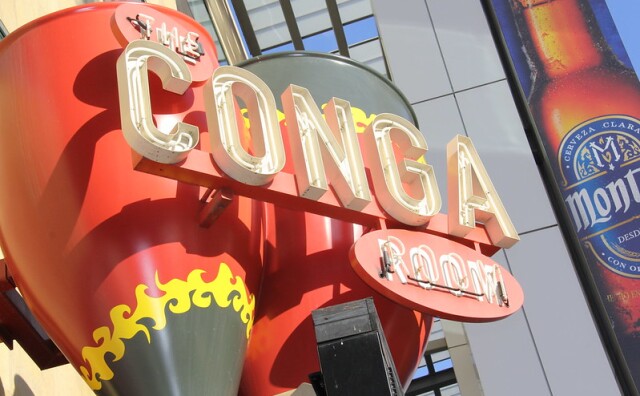From Illegal Graffiti To Commissioned Murals — The Hustle Of One Artist

Red Ortiz has cut his hand, fallen off a roof, gotten arrested — all for the thrill and love of graffiti painting.
The nights, and days, that he invested in carrying cans of paint to different L.A. spots (and dodging police) paid off for him.
“I learned a lot of stuff through graffiti, illegal graffiti, that became a positive impact in my life,” Ortiz says. “And now I'm making a living off of my art.”
-
Delta flight from JFK to LAX turned back Friday
-
Ideas for putting those pesky piles to good use
-
Now in effect in the city of L.A.
The L.A. towers
Illegal graffiti in L.A. began to have another moment when the painting of the empty Oceanwide towers in downtown made international headlines. The buildings went unfinished because Oceanwide, a developer, didn’t have the money to complete them in 2019, and the company is now facing involuntary bankruptcy.
The L.A. City Council approved nearly $4 million to fence off the area and remove the graffiti from the three towers. City officials hope to recover the money from the company, but there aren’t any guarantees.

For Ortiz, the illegal graffiti on those buildings is part of L.A. culture — at least his culture.
“I thought it was like a great expression of L.A. It kind of represents L.A.,” he says. “These people were out there, like, risking it and, like, sneaking in … People [were] literally there expressing themselves and doing what it takes.”
Ortiz hasn’t painted the L.A. towers, and probably won’t do so, he says, but he respects the work of his fellow artists. He says he knew artists who scaled the building, brought buckets of paint and spent hours trying to create art without really knowing the finished product.
“That's the beauty of it,” he says. “In reality, it is just people using their mind and their abilities and like, ‘Alright, I’ma measure this out,’ so it's a lot of detail that goes into it that really doesn't get acknowledged.”
His own start in graffiti
But Ortiz’s career has been somewhat acknowledged.
He collaborated with artist Levi Ponce (whom he nods to having a big impact on his career) on Pacoima’s largest above-ground mural. He’s been interviewed by the Spanish-language radio station Que Buena about his Kobe Bryant murals. His Nipsey Hussle memorial was shared on social media by LBC legend Snoop Dogg and Sen. Alex Padilla, who called the mural “stunning.”
These pieces were paid commissions, but years ago, Oritz was a different kind of street artist.
“I was tagging on people's driveways and garages and not knowing that's like the dumbest sh** you could do,” he says of his elementary school years.
Later on, he began tagging freeways in his northeast San Fernando Valley communities, and started painting overnight to avoid authorities or neighbors.
His skills improved and he wanted to showcase his art more. Ortiz noticed cargo trains travel longer distances, so he chose to paint those — always evading police or train workers.
“It's just so dark,” he says. “And then like the only light you have is the moonlight shining down on you. You don't realize how powerful the moon is until you're really in pitch black darkness.”
Ortiz says all that work — in the dark, rushing to avoid police, strategizing scale and figures — led him to apply it to paid work. He’s a film director, videographer, photographer and has worked with artists Eddie Zuko and Tyga.
On film sets, they would ask him to paint a background to look like a sky; Ortiz already knew his way with a brush. By knowing how to detail letters, he applied those skills to another business: barbering.
“It all came from graffiti, man,” he says. “Just kind of like the detailedness and the art form and just translating that to other forms of business.”
That's one Angeleno's relationship to graffiti. There are thousands of other graffiti writers in L.A.
Every year there are hundreds of thousands of new reports of graffiti throughout the city, according to 311 data — anything from quick tags to large and complex murals like the ones that appeared on the downtown L.A. towers.
I asked Ortiz for his artist’s perspective. What did he think about those towers? Was this graffiti art or vandalism?
“I would just say there's like so much more things you could worry about, that matter way more than trying to take graffiti off a wall; there's a lot of people struggling,” he says. “It would take a lot of money to fix those buildings and I don't think it's ever going to happen.”
Producer Evan Jacoby contributed to this report.
-
Samy Kamienowicz, the man who founded the retail camera stores and became a fixture for the city's creative community, has died. Los Angeles pays tribute.
-
The music will live on through the nonprofit Conga Kids.
-
Known for its elaborate light displays, this year, the neighborhood is expecting a bigger crowd tied to the release of “Candy Cane Lane” on Amazon Prime Video.
-
Dancers at Star Garden demanded better working conditions — including protection from aggressive guests. Up next: An actual contract.
-
The Alliance of Motion Picture and Television Producers rejected the SAG-AFTRA union's request for a separate type of residual payment that actors would get once their programs hit streaming services.
-
Sarah Ramos says she actually likes self-taped auditions, but without regulations: “This is a strain on our resources, a strain on our community and it's untenable.”






